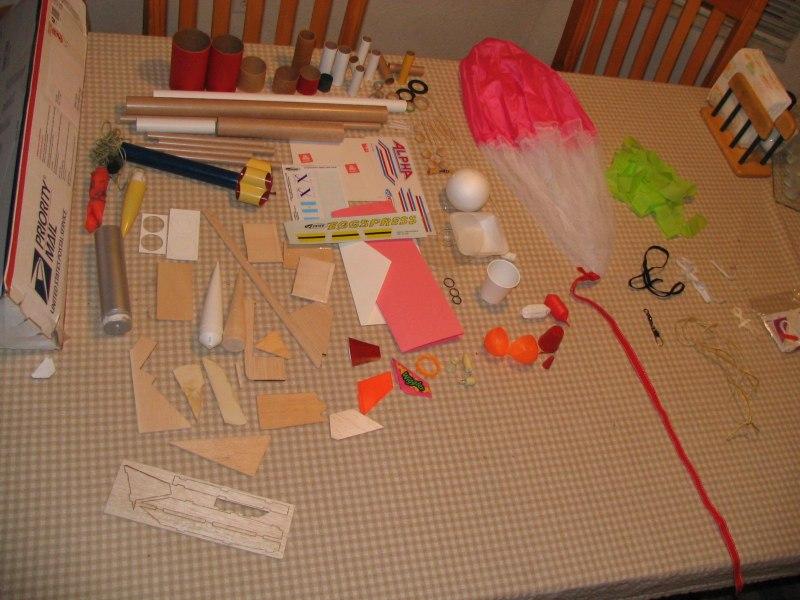Scratch Xebec Kaku Original Design / Scratch Built
Scratch - Xebec Kaku {Scratch}
Contributed by Brian Coyle
| Manufacturer: | Scratch |
Backstory
In the mid-2100's, Earth's leaders realized the biggest issues facing the world were not the depletion of natural recourses, famine, or even the impending fresh water shortages. The human race itself was in jeopardy and needed to expand into the stars if it were to survive. In a gallant effort of worldwide cooperation, plans were put into motion that would construct a number of long range starships capable of sending humans to establish space colonies in neighboring galaxies. The Xebec Kaku is the first in a series of these Rapid Deployment Colonization Spacecraft (RDCS).
Assembled in Earth orbit where aerodynamics are unnecessary, only the forward sections of the three ion-propulsion generators offer the hint of sleekness in the ship. The spherical crew compartment and long beam at the nose of the ship elicits memories of the fictional XD-1 Discovery from 2001: A Space Odyssey. The central section houses the quantum communications equipment, navigation, landing supplies and connects the main plasma propulsion system with all other portions of the starship.
Three crew evacuation pods surround the crew compartment with one near the quantum communications center. The Zebec Kaku is a stark, purpose-built transport with few amenities and very little exterior equipment. A typical RDCS mission profile consists of firing the main plasma system to escape the solar system, followed by sustained use of the ion-propulsion generators to reach a suitable planet to colonize.
Design
The initial design effort was time consuming. There were so many parts supplied in my contest box, I wasn't sure where to begin. An inventory upon opening the box revealed both the volume of components and the variety. Included were traditional parts like nose cones, body tubes, couplers and motor mounts, but also odd-ball items: a plastic Solo cup, a clear CD-ROM, wooden buttons, even a partially destroyed 'Tuber' rocket. What I initially thought were epoxy mixing containers turned out to be tare dishes for weighing chemicals.
My first approach was to layout the parts into categories with hopes a design would magically reveal itself on the kitchen table. After several nights of this (and a few days staring at the parts photo), it became clear I might have to resort to pouring glue into the box and shaking the parts just to see what would pop out. I couldn't help but feel like one of the Apollo 13 engineers trying to build a CO2 scrubber...
During this time, I was reading 'Physics of the Impossible' by string theorist Michio Kaku. The book provided much inspiration and solidified the science FACTion aspects of my entry. Eventually, the Styrofoam ball, Solo cup and long tube were placed end-to-end along with the three nose cones and some tubes forming the foundation of something looking vaguely like a rocket..
Since this would model a starship constructed in space, fins would not be needed. I decided to employ the flat plate aerodynamics of spool rockets to stabilize my entry. The CD-ROM and tare dishes became plasma and ion propulsion components.
A starship was beginning to take shape!
Early on, my grand plan was to gain bonus cluster/deployment points by populating the ion-tubes with 18mm motors and ejecting a Rogallo glider and helicopter. But this was quickly discarded as construction began, complexity increased and time became short.
Construction
Once it became apparent this model was going to rely on simple parachute recovery, I had to find the appropriate part in the box to handle the estimated final weight (already approaching 12 ounces). A beautiful 28” pink nylon, tangle-free chute was the obvious choice. (Many thanks to the contestant that included it! This single part was worth the price of entry). The folded size of the chute in turn drove the selection of the 2.5” diameter coupler part to contain it during boost.
This coupler also just happened to match the round portion of the tare tray bottom. After removing this section, two trays were glued together and slid over the coupler to create an interesting looking body part.
Despite the coupler being 4” long, more space was still needed to include the approximately 50” of 1/8” Kevlar® recovery harness. This was accomplished by adding a 2.75” cardstock transition between the coupler and the 9” BT-55 that extended to the rear 29mm thick-wall motor mount tube. I used DJ Delorie's excellent Body Tube Transitions web site to print the cardstock template. After assembly, the cardstock was hardened with thin CA.
The large coupler created a natural separation point in the middle of the model. A piston was fabricated from an envelope and three discs cut from the shipping box. The envelope was folded over to be 2.25” long, rolled and glued into a cylinder to fit inside the coupler. One disc was glued just over 1/2” inside the piston to form the blast bulkhead. The remaining discs were cut into centering rings to match the piston and forward beam tube. These were glued 1/4” apart at the end of the tube, then the entire assembly glued to the front of the piston. The recovery harness was connected to the piston and coupler tube using cardstock tri-fold mounts.

Three small triangles of 1/8” balsa were added 120 degrees around the tube for support and more importantly, to provide a resting point keeping the piston from sliding into the coupler. These support members extend about 1/8” beyond the diameter of the piston.
The motor mount and CD-ROM were the next parts to assemble. The center of the CD was enlarged just enough to insert the thick-wall 29mm MMT tube about 1/2 inch, then this was attached to the BT-55 that made up the aft section of the rocket. Due to the different materials, Gorilla glue was used.
Soon after finalizing the design, I accepted the fact nose weight would be needed. An attempt to insert clay into the Styrofoam ball proved it was more solid that originally thought. Instead a few ounces of clay was placed into the Solo cup and forward portion of the 18” beam tube. The tube, cup and ball were all assembled with generous amounts of Gorilla glue and left standing vertically to cure overnight.
Next the Tuber rocket was disassembled to utilize the nose and 7.5” of tube for an ion-generator. Slightly longer sections (9”) of BT-55 were paired with NC's for the other two. Tare trays were carefully cut to allow the tubes to slide in so the aft end was even with the dish edge. This formed the ion-propulsion plates.
Small sections of BT-5 were cut to provide a support structure attaching the ion tubes to the main rocket body. Two pieces 1” long were used on the forward BT-55, while one 1.125” section was used on the BT-50 Tuber body. The aft components are 1.875” and 2” long respectively and insert thru holes cut into the base of the tare trays. The BT-5 tubes were Gorilla glued to the tubes such that rear tubes meet the aft transition and the forward tubes are centered 0.75” from the front edge of the parachute coupler.
A 4.25” length of BT-5 for a launch lug supported by a scrap of balsa was installed along one of the BT-55 tubes. The lug extends through the tare tray like the body tube and is positioned to allow the launch rod to clear the Styrofoam nose and aft CD-ROM.
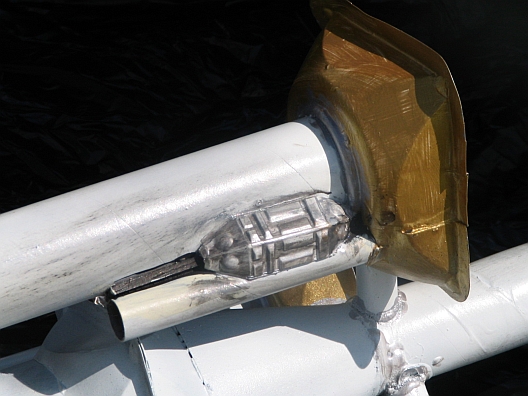
Final steps of the construction include the addition of tiny 'nurnies' and 'greebles'. Buttons were used to simulate the escape pods. A plastic part believed to originate from an Estes Meteor Masher was cut lengthwise into three sections. Two sections were placed on either side of the launch lug, with the third part added crossways to the quantum communications bay.
The end result is a mid-powered model 43 inches long, with a dry weight of about 14 ounces.
Finishing
The best thing about designing a future fantasy / science fiction model is the finishing. Nobody can claim the poor paint, or rough surface isn't supposed to look like that! That's the effect I attempted to capture with the Zebec Kaku. Excess Gorilla glue was left to expand at part joints, later painted silver to simulate hoses, spherical tanks and 'space blankets'. Pieces of cellophane tape were left attached and painted with the Styrofoam ball giving an interesting panel appearance.
The base primer was equipment gray which along with reduced, uneven flat white top coats gives the impression of a ship manufactured over time in the harsh vacuum of space. Gold brush-on paint was used for the exterior of the ion-generator plates, with silver used on the inside and small exterior parts.
Powdered graphite and black India ink was dabbed on with a cotton ball to produce weathering effects. The graphite was applied with short to medium length strokes, always starting at a protrusion and moving towards the tail of the model. The ink was used to draw out the details of panels and indentations on the small parts.
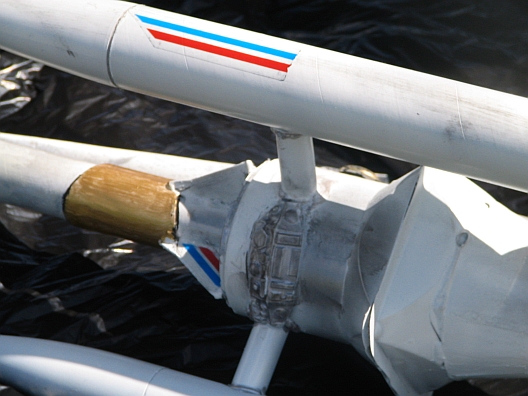
A minimalist approach to color decals was used. Straight sections of the red and blue Estes Alpha peel-n-stick decals were attached to the outward facing ion tubes, near the nose cones. Smaller pieces were affixed to the beam support 'fins' at the center of the model. A pair of nameplates printed with a red font and blue underline complements the color scheme.
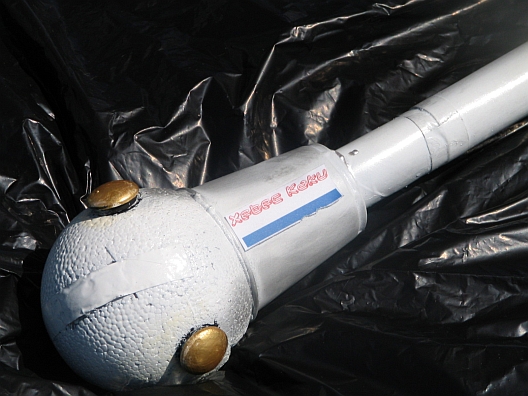
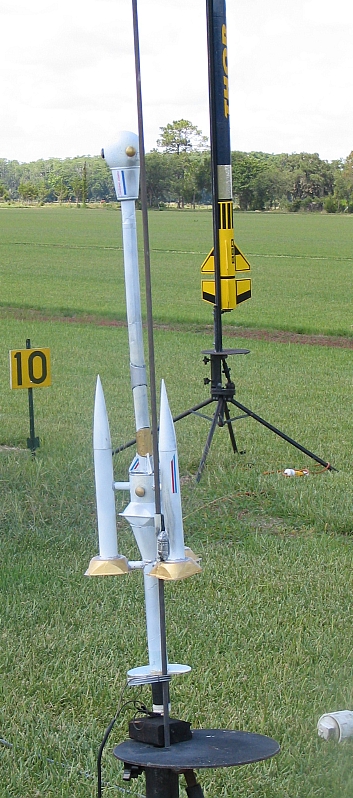 Flights
Flights
The unusual design of Xebec Kaku made a RockSIM flight simulation impossible (although I did attempt to hack one together for grins). And despite passing several swings tests with G80 and G64 motor configurations, the model is probably best described as marginally unstable.
The first flight, launched unpainted on a Road Runner G80-4, left the rod, caught a wind gust and immediately looped several times. It gained perhaps 75 feet in altitude before crashing then deploying the ejection charge.
This unsuccessful flight also exposed a weakness in the initial design of the long beam tube- it folded over at
some point either during the flight or during the hard landing. The model returned to the workshop for modifications
that would hopefully address both the beam strength and stability.
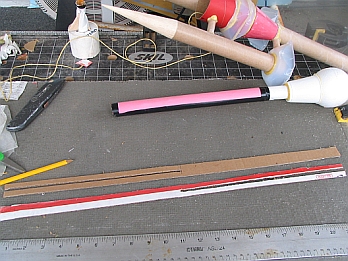 The beam tube was improved by an internal cruciform structure (fabricated from the shipping box)
running the length of the tube. The length was also extended by the addition of a 5” piece of tube coupled
together with two of the Tuber rocket fins. More clay was also added to the forward end of the assembly, which combined
with the longer moment moved the flight-ready CG forward by 1.5” to the front of the transition.
The beam tube was improved by an internal cruciform structure (fabricated from the shipping box)
running the length of the tube. The length was also extended by the addition of a 5” piece of tube coupled
together with two of the Tuber rocket fins. More clay was also added to the forward end of the assembly, which combined
with the longer moment moved the flight-ready CG forward by 1.5” to the front of the transition.
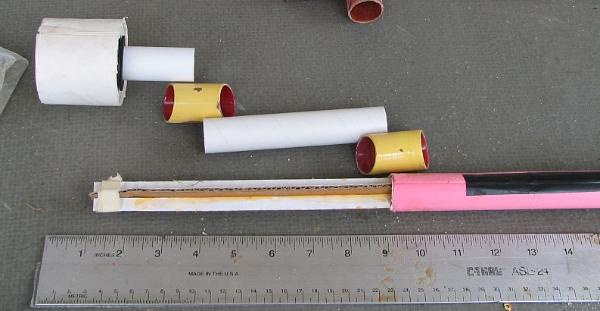
The second flight (fully painted) was on an Aerotech G64 with the delay drilled to 4 seconds. This time the rocket remained stable as it left the launch rod.

But as propellant burned away and the thrust began to drop off, it began tracing large circles in the sky, reaching an estimated 125 feet in altitude before once again slamming hard into the ground. This crash broke off one of the ion-propulsion tubes and destroyed the CD-ROM plasma plate ruining any possibility for a third flight.
Summary:
Although the initial incarnations of Xebec Kaku proved to be unstable, I believe with additional tweaks and a bit of time, this unusual design can become flight worthy. This was a great contest and very challenging – probably more so due to my desire to pursue something “outside the box”. Plus I have enough parts remaining to build many more rockets. My thanks to Nick and Todd for coordinating everything! Best of luck to all the contestants.
Video credit: Jimmy Yawn
Sponsored Ads
 |
 |
